While it is also the earliest spring ever here for crocus to start blooming, it is nowhere near as advanced as the much more southerly and/or warmer areas we've been seeing here... but things are progressing!
1) There will be flowers open today on the most precocious of various self-seeded Hepatica nobilis; the leaves on hepatica take quite a beating over the winter here, so it seems it is only much warmer areas that can produce those photos showing spectacular flowers and beautiful leaves at the same time!
2) Pulsatilla vernalis
3) Potentilla nivea
4) Potentilla porphyrantha
5) Calyptridium umbellatum (evergreen)
6) Inula rhizocephalum
7)Caltha leptosepala
8 ) Flower buds on Androsace carnea alba; Aethionema saxatile in the background; both are evergreen
9) Furry little nubbins on Pulsatilla campanella
10) Gentiana verna is evergreen
Comments
Re: Signs of life
Now open, it's modest but it is the first! This seedling Hepatica nobilis shows the sort of ratty old leaves that are typical here... the new leaves get to be in good form pretty well after the bloom is done. I love the colour of these (not quite captured by my camera) - the standard, rich royal purple on an ordinary flower form suits me much better than any of the exorbitantly expensive hybrids!
Re: Signs of life
Lori, seems like spring is springing into action for you. Love the golden-haired bud on Pulsatilla vernalis. What is Potentilla porphyrantha like... where is it from? An old friend, Calyptridium umbellatum... I used to grow these by the dozens, they can be quite variable, fun little urchins to grow.
After unseasonably mild weather early on, last night went down to 18 degrees F (-9 C), slowing things down a bit :(
Re: Signs of life
Yes, spring is slow in coming here, but a very exciting time!
I'm not personally familiar with Calyptridium - it doesn't occur this far north. I grew some from seed last year, planted them in various places and am hoping I get to see blooms this year!
Potentilla porphyrantha is one of the pink-flowered potentillas, this one from the Caucasus. In The Caucasus and It's Flowers, Holubec and Krivka describe it as endemic to Armenia and Nakhichevan (http://en.wikipedia.org/wiki/Nakhchivan). There are a couple of nice pictures in the book, of course. I bought the plant from Beaver Creek (http://www.rockgardenplants.com/plantcatmain.htm) a couple of years ago.
Here's a close-up of the flowers, from last year:
Re: Signs of life
Yes, spring is slow in coming here, but a very exciting time!
I'm not personally familiar with Calyptridium - it doesn't occur this far north. I grew some from seed last year, planted them in various places and am hoping I get to see blooms this year!Potentilla porphyrantha is one of the pink-flowered potentillas, this one from the Caucasus. In The Caucasus and It's Flowers, Holubec and Krivka describe it as endemic to Armenia and Nakhichevan (http://en.wikipedia.org/wiki/Nakhchivan). There are a couple of nice pictures in the book, of course. I bought the plant from Beaver Creek (http://www.rockgardenplants.com/plantcatmain.htm) a couple of years ago.
Here's a close-up of the flowers, from last year:
Ooohhh, one of those pink-flowered Potentilla beauties... nice! The Calyptridium is a "hoot", a funny little prostrate plant... the succulent foliage is most variable, often wrinkled and delightfully dimpled, and tinged with color, and the fluffy "catkin-like" flowers on prostrate stem "spokes" are quite amusing and attractive. It is not long lived, but so easy to raise from seed. Great for troughs.
Re: Signs of life
Hope you continue posting picture of spring flowers! Where I am now all is covered by 3' of snow. We are going to stay here for a week (must be crazy seeking out the snow when the spring is unfolding at home and a lot of tidying up need to be done back home!).
Re: Signs of life
I posted my Crocus and Scilla in their respective threads but here is my Galanthus nivalis 'Flore Pleno' and regular form.
Re: Signs of life
And here is my Eranthis hyemalis...no Hepatica or Pulsatilla yet so Lori you are well ahead of me!
Re: Signs of life
I posted my Crocus and Scilla in their respective threads but here is my Galanthus nivalis 'Flore Pleno' and regular form.
Seems like spring has finally arrived for you. When I posted a photo of what was eventually identified as Galanthus nivalis 'Flore Pleno' on the Scottish Rock Garden Club forum, in a thread about snowdrop identification, I was told by a galanthophile supplying the ID that it was an ugly plant and he wouldn't have such a thing :o >:( :o,
I think it is pretty nonetheless, in spite of disparaging comments, my clump is not nearly as large as yours.
Re: Signs of life
After 5 days of rain and cloudiness, the sun shone today and it became very warm; everything is ready to grow:
1. Epimedium x versicolor 'Versicolor' - fuzzy shoots emerge
2. Epimdeium grandiflorum 'Red Queen' - red shoots emerging
3. Aster sericeus - fuzzy rosettes emerging, a dryland Aster... thanks Panayoti!
4. Allium crenulatum 'Olympic Sunset' - shoots emerging
5. Trillium decumbens
6. Jeffersonia dubia & Primula kisoana - emerging shoots
7. Pulmonaria - named forms don't last, self-sown seedlings from them do.
8. Corydalis nobilis - a powerful species with beautiful foliage.
9. Corydalis solida - colorful seedlings, lots of good reds... joyful ephemeral weeds
Re: Signs of life
I have a clump of G. 'Flore Pleno' myself but I have to admit that I like the ordinary form better! I have 8-10 different selections of Galanthus I think. I am very excited by the thought of how far the spring has come when I finally arrive home (only one week away but still...). That's the worst - and best - by travelling!
Pulmonaria and Corydalis I have in swarms. They self-sow but not true to type! Corydalis nobilis is short lived here but I know it is very popular and easy in the northern part of Norway.
I try to gather a population of Jeffersonia in my woodland but have had limited success, not that easy from seed?
And Eranthis! Have tried many times but something nasty eat all the plants and the seedlings every time!
Re: Signs of life
More signs of life...
1) Adonis amurensis 'Fukujukai'
2) Balsamorhiza hookeri var. lagocephala
3) Besseya alpina from seed last year, emerging.
4) Corydalis nobilis, going into action here too.
5) Corydalis magadanica, still tiny, from a planting in 2008.
6) Pulmonaria altaica
7) Dracocephalum palmatum - actually, this one is evergreen, and always winters over very well. Perhaps it will finally bloom this year! (I grew some of these from seed a few years ago.)
Re: Signs of life
My signs of life: Pulmonaria angustifolia, Pulmonaria montana, Saxifraga 'Marianne', Viburnum X bodnantense
Re: Signs of life
I have to agree, the double forms of galanthus are a little weird, but this clone is a most reliable bloomer.
Re: Signs of life
Wow, you are way ahead of us now, Todd!
Re: Signs of life
I love this thread! There is nothing as tantalizing as the shape, color and form of new shoots emerging. Lori, tell me more about Pulmonaria altaica. Last year, at a late summer NARGS plant sale I bought 6 plants of Corydalis magadanica, which flowered even as young plants with yellow and brown marked flowers, none are up and all look dead >:(
A few items that caught my attention today:
1. Dicentra cucullaria surging out of the ground, have these beauties everywhere.
2. Paeonia wittmanniana leaf buds - taken in low late afternoon light. Love the look of these muscular buds.
3. Paeonia wittmanniana leaf buds - taken in brigh morning light, red and lively.
4. A very tiny Viola species with pointed (not rounded) variegated leaves.. V. selkirkii?
Re: Signs of life
Things don't evolve fast here even without freezing temperatures. Been away for a week and the snowdrops and many crocuses are finito but new plants slowly emerge. It is still early morning and I have not taken many pictures yet! Here are two:
I like cardamines and one of the first to bloom is C. enneaphylla.
The other is my only palm, still alive seemingly after a harsh winter.
Re: Signs of life
Mark, Pulmonaria altaica is an introduction from Siberia by Josef Halda, according to Wrightman's, source of my plant in 2008:
http://www.wrightmanalpines.com/details.asp?PRODUCT_ID=P077
It is quite lovely - the leaves are finely felted and soft as a black lab's ears, and the flowers are quite large:
Re: Signs of life
I have several pulmonarias but not altaica. Nice color.
Here are some more plants from the deep woods.
Re: Signs of life
You will make many of us jealous with that meconopsis, Trond!
1) Helleborus cyclophyllus Acck! It's actually Cardamine enneaphylla... which will likely get snowed on again before winter is over - won't look so perky then.
2) Polemonium confertum, spreading around a bit in the trough
3) Salvia pachyphylla, from seed last year, seems to have come through the winter, though it is in a very exposed spot.
4) Aquilegia laramiensis... very long-lived, and apparently, not inclined to promiscuous hybridizing, unlike its fellow species.
5) Erythronium dens-canis
6) Phlox multiflora, coming back to life
7) Draba acaulis, with buds forming - oops, guess I forgot the picture!
8, 9) Leptodactylon pungens ssp. pulchrifolium, gnarly but alive!
Re: Signs of life
I don't know Lori...I still think you are ahead of me! Here is Helleborus orientalis hybrid and niger
Re: Signs of life
The maiden bloom of Helleborus purpurescens in the oh so dry garden today. I hadn't expected the flowers to be very spectacular. It's the foliage that is cool.
Re: Signs of life
The maiden bloom of Helleborus purpurescens in the oh so dry garden today. I hadn't expected the flowers to be very spectacular. It's the foliage that is cool.
Yes, Rick, I have come to appreciate the leaves of the different plants more and more and take the flowers as an extra bonus of course.
To Lori: You all have plants that make me jealous! Often I see (pictures of) plants I know I can't grow well and that makes me, well, jealous! But then I think if everybody grew all kind of plants to perfection, where were the excitement? Often I try plants that by the books doesn't grow here, and that is right, but then some do grow well and I am happy!
Re: Signs of life
Mark, Pulmonaria altaica is an introduction from Siberia by Josef Halda, according to Wrightman's, source of my plant in 2008:
http://www.wrightmanalpines.com/details.asp?PRODUCT_ID=P077It is quite lovely - the leaves are finely felted and soft as a black lab's ears, and the flowers are quite large:
I agree that this is a lovely species, one I've not heard of before... looks almost Mertensia-like in habit. Lori, could you add this species with pics to the Pulmonaria thread I started, it would be useful to help complete the Pulmonaria picture by adding the info there. Thanks.
PS. I'm wondering the if the finely felted leaves are as soft as a golden lab's ears? ;D
Todd, similarly, if you have any more photos of Pulmonaria montana, maybe add them to the Pulmonaria thread... looks like that species is another reddish-flowered one like P. rubra? I'm not familiar with P. montana either.
Re: Signs of life
Todd, how large does Salix cordata grow? I like the large catkins. Also cool is the foliage on Centaurea empirota... can I assume it is Turkish? The Erica carnea 'Heathwood' is a stunner, flowers contrast nicely with black-green foliage.... adding to my list :)
Lori, a bought about 6 plants of Corydalis magadanica at a NARGS chapter plant sale last September (for about 25 cents each), although small they flowered with yellow brown-marked flowers after being planted out. None has resurfaced this spring! I do like the leaves of Polemonium confertum; in the just-emerging stage they look like baby fern fronds... must try some of these again. I have also always wanted to grow Leptodactylon species, including pungens... maybe I should give it a try if it is hardy for you.
Trond, you can grow Meconopsis? It is much too dry and hot here in summer. Can you grow a number of species, or just the ones with spines like M. horridula, where the slugs get impaled trying to eat the plant ;D I like the look of Cardamine enneaphylla, with fleshy rubber-like leaves when they first emerge... if they make any seed, please spare me a bit (and I'll save some Jeffersonia dubia for you) :)
Re: Signs of life
Trond, you can grow Meconopsis? It is much too dry and hot here in summer. Can you grow a number of species, or just the ones with spines like M. horridula, where the slugs get impaled trying to eat the plant ;D
I can grow several Meconopsis. The molluscs seem not to like them. I have had many, but often they are monocarpic In fact one of the pest species I have is M. cambrica. I am not sure how many I have this year, have to see what comes up. Except M. cambrica they seldom self seed.
I like the look of Cardamine enneaphylla, with fleshy rubber-like leaves when they first emerge... if they make any seed, please spare me a bit (and I'll save some Jeffersonia dubia for you) :)
That's a deal!
I have other Cardamines too: pentaphyllos, heptaphylla, trifoliata, bulbifera etc. C. pratensis is very common in the wet fields around here.
Re: Signs of life
Nice cardamines... I only have a couple, C. trifoliata and ?? (have to refer to records)
Yes, Meconopsis cambrica is one that would probably allow most of us to make the claim that we "successfully grow meconopsis". ;D ;D It self-seeds but is not pestilent in my dry conditions.
Re: Signs of life
That's a deal!
I have other Cardamines too: pentaphyllos, heptaphylla, trifoliata, bulbifera etc. C. pratensis is very common in the wet fields around here.
Not mentioned in your list, but shown as one of your photos is C. waldsteinii... that one looks awesome... such large flowers. Yes please to seed on that one, if you get seed... and the only other one I grow currently is pentaphylla, but I'm always looking to increase my Cardamine representation. :D
Regards,
Mark
Re: Signs of life
]
Not mentioned in your list, but shown as one of your photos is C. waldsteinii... that one looks awesome... such large flowers. Yes please to seed on that one, if you get seed... and the only other one I grow currently is pentaphylla, but I'm always looking to increase my Cardamine representation. :DRegards,
Mark
waldsteinii is the etc part of the list!
I shall collect all the seeds I can! Heptaphylla is almost as nice as waldsteinii.
Trond
Re: Signs of life
My mistake Mark....P. montana is the old name for P. rubra...time I got up to speed with the new (or not so new) names.
Trond I'm jealous of your Cardamine...I've never had any luck with the couple I tried (probably too much overcrowding) and access to them is difficult in Canada. Save some seed for me too! I'd like to give them a try again.
The worse plant in my garden is probably M. cambrica...hard to get rid of the little blighters. If the plant didn't have such a long blooming season I'd irradicate it altogether.
Re: Signs of life
In our Big Woods ecosystem, the wild garlic (Allium tricoccum) and Dicentra cucullaria have been up for a while now.
Re: Signs of life
Lori,
Pulmonaria altaica is a species I not have seen before. Looks great with huge blue flowers! I have not tried Helleborus cyclophyllus assuming it wouldn't tolerate wet winters. And this Leptodactylon of yours looks spiny! Haven't seen that either.
Rick,
I have seen Cardamine laciniata pictured but not live, looks nice.
Re: Signs of life
Apparently, Cardamine laciniata is quite variable. The pic I took is of our wild phenotype in the Minneapolis, Minnesota area. It blooms very sparsely and the flowers don't open very wide at all. Like all (or most?) variations of this species, flowers open only when it is warm and sunny.
I have seen photos of much better forms from other parts of the country. So if you look for plants or seed, I would try to stay away from a Minnesota source.
Re: Signs of life
Some more signs of life 2010:
1. Allium altyncolicum - allied to chives (A. scheoneoprasum) but with spikey erect blue leaves. Love it!
2. Allium hymenorrhizum - robust form, beautiful Christmas red stem bases with falcate green leaves. To 30" tall.
3. Clematis fremontii - a weird relic, reliable but impossibly slow growing. Fuzzy urn flower(s).
4. Anemomopsis macrophylla - just sprouted today, in one day, a remarkably beautiful plant in flower.
5. Aster (now Ionactis) linariifolius - tiny dense shoots; ouch, watch out for the tough old stems. Rock garden gem. Variable.
6. Paeonia wittmanniana - shoots, a muscular species with single cream-yellow flowers, a large beauty.
7. Paeonia 'Buckeye Belle' - wow, can you say RED... red shoots but the amazing flowers are glossy deep blood red.
8. Saxifraga fortunei - pink form, flowers in October with beautiful delicate pale pink flowers, a woodland gem.
9. Thalictrum minus 'Adiantifolium' - a treasured plant here, filiform masses of tiny yellowish flowers.
10. Saruma henryi - an anagram of the related Asarum, furry foliage and showy yellow flowers, love this plant!
Re: Signs of life
Some more signs of life 2010 continued - those with asparagus shoots ;-)
11. Amsonia rigida - one of the most consise Amsonia species from southeastern USA, a great perennial.
12. Baptisia sphaerocarpa - bold spires of yellow against blue-green foliage.
13. Cynanchum ascyrifolium - my absolute favotite asclepid perennial, long season of white flowers, concise.
14. Kirengoshoma palmatum - wonderful late summer show of large yellow bells, great foliage too... needs WATER!
15. Uvularia_grandiflora - an essential woodland garden plant, fab foliage, erect then drooping habit, large yellow flowers.
Re: Signs of life
According to the TV-news here New York has beaten all time high for April temperature? Is this true for your place too, Mark? No wonder why your plants grow fast. Here we will have sun the coming week but the air is a little colder (from the Arctic) so we probably get frosty nights. I'll take some pictures later today.
Re: Signs of life
According to the TV-news here New York has beaten all time high for April temperature? Is this true for your place too, Mark? No wonder why your plants grow fast. Here we will have sun the coming week but the air is a little colder (from the Arctic) so we probably get frosty nights. I'll take some pictures later today.
Well, we always get a few of what I call "stupid days" in early spring, where suddenly it gets hot as if the middle of the summer, but it only lasts a couple days at most, then back to more normal temperature. But yes, last week we matched the record for the hottest day in April on that particular day, 86 F (30 C). But this spring it has been mild overall, some record breaking rainstorms of several days each that caused lots of flooding, but the deep rains, followed by periods of mild sunny days and no frosty nights, caused a compressed spring explosion of growth, 2-3 weeks earlier than normal, and many things blooming at the same time that don't normally bloom at the same time. As long as we don't get whacked with a freezing cold snap, I'm not complaining. :)
We even have Magnolias and Bradford Pear trees in bloom, unheard of! Here's my seed-grown M. stellata - pink form.
Re: Signs of life
In our Big Woods ecosystem, the wild garlic (Allium tricoccum) and Dicentra cucullaria have been up for a while now.
Rick, do you ever see any pink Dicentra out in the Big Woods? Regarding Allium tricoccum, it is a species that interests me... so common, yet actually scarce horticulturally. I notice your Big Woods plants have red leaf petioles. Do you grow it in the garden... ever eaten the leaves, they're supposed to be good.
In 1979 a minor variant of A. tricoccum was separated out as it's own species, A. burdickii ::), which was rather silly I think. The USDA still maintains it as a species, but checking the online Flora of North America at http://www.efloras.org/florataxon.aspx?flora_id=1&taxon_id=242101410 shows that at best, it is merely a variety of tricoccum. However, even with that, if you look at what separates the so-called variety burdickii, there is much overlap with var. tricoccum, and in the end of their treatment, it says "with its overlapping characteristics and distribution, Allium tricoccum var. burdickii is doubtfully separate from var. tricoccum".
Re: Signs of life
What a splendid Magnolia stallata Mark! I have a white one myself (and not flowering yet - waiting for warmer weather).
Here are some plants, pictures taken today.
1) Gagea lutea is a wild spring flowering plant in Norway.
2) I have lots of hellebores, all from seed. This is H. orientalis.
3) The common wild Hepatica nobilis (blåveis) is certainly the spring flower here, but common only in south and east. of Norway.
4) Hepatica transsylvanica is better than nobilis here on the west coast.
5) I have lots of Paeonia too, from seed.
PS. 3) The front leaves are ivy, the upper right is Hepatica leaf.
Re: Signs of life
Some things are looking a little depressed here, after about 1" of wet snow on Thursday afternoon/evening and -10 deg C overnight... supposed to be snow flurries Sunday through Wednesday. Oh well, it's still been an early spring.
1) Burly shoots of Allium obliquum. There are lots of little two-pronged seedlings around it, too.
2, 3) First butterfly I've seen this year - Milbert's Tortoise Shell.
4) Lathyrus vernus gracilis
5) Helianthemum oelandicum ssp. alpestre is evergreen, but the stems and leaves redden rather nicely in spring.
6) The current state of Corydalis solida (actually this photo was pre-snow; a little droopy now).
7) Paeonia anomala
Re: Signs of life
Some things are looking a little depressed here, after about 1" of wet snow on Thursday afternoon/evening and -10 deg C overnight... supposed to be snow flurries Sunday through Wednesday. Oh well, it's still been an early spring.
Snow is not the worst, I would be very anxious if the thermometer dropped that much, fortunately it is very uncommon here (-1 oC last night).
Re: Signs of life
I would be very anxious if the thermometer dropped that much, fortunately it is very uncommon here (-1 oC last night).
Well, it happens every year for at least a week in April... things are so less advanced here than where you are, that it really usually has little effect.
Re: Signs of life
Lori - tell me about Lathyrus vernus gracilis, I don't know the "gracilis" subspecies or variety; are the leaves extra narrow? What color are the flowers. On your Allium obliquum, that looks like an amazing robust form, beautiful shoots... do you have a pic when in flower. Please remember me for seed on this one, I used to grow it but no longer have it.
Trond - Your Hepatica nobilis is a nice clear blue; I need more forms of Hepatica, and blue ones too, all I currently grow is a pink-flowered form of acutiloba, which I moved to a moister spot and it is flowering and growing better than under drier conditions. And both you and Lori showed Paeonia shoots... aren't they amazing! :D
Re: Signs of life
1, 2) Yes, Lathyrus vernus 'Gracilis' does have very narrow leaves.
3, 4) Here, too, is my Allium obliquum ... no problem saving seeds for you, if you want some. It is very tall - about 3' or more.
Mark, your Baptisia sphaerocarpa and Cynanchum ascyrifolium look and sound very interesting, and completely unfamiliar to me. Can you show us more pix of them?
Re: Signs of life
Mark, native flora books say there are pink forms of D. cucullaria in MN/WI (not rare, but I don't know how common), but I have never seen any myself.
Not that I have seen a lot of Allium tricoccum, but I do know them from an area a mile from me and a couple areas 100 miles to the south. All have the red leaf stems. I've never tasted the leaves. Never thought about it, actually. I only discovered the ones right under my nose a couple years ago, and my aim is to gather some fresh seed to propagate. They are not that common in this area for me to feel okay about digging bulbs, and although they proliferate to the south, my moral judgment precludes me there also.
Last summer when I checked on the flowering of the ones close to me, they were attacked by some insect producing a mealy bug effect. I didn't have time to closely inspect them then, and never returned to follow up. Could it be woolly aphids? They are known here, and I get them on my Alnus glutinosa and Alnus x spaethii.
A search this past week revealed a second small colony and few more scattered individuals near me. Maybe I'll have better luck collecting seed this year.
The supposed differences between var. tricoccum and var. burdickii certainly seem trivial for a varietal designation. It would seem the rank of forma is more appropriate (he says, posing as a taxonomist wannabe.)
Re: Signs of life
Nice Lathyrus Lori.....I think I have that one too but under another variety name....I'll have to check my records.
Just about to place my order with Wrightman's Alpines. My order includes Androsace mariae, Arnebia echioides, Dracocephalum imberbe, Hirpicium armerioides, Moltkia petraea, Mertensia alpina, Phlox kelseyi 'Lemhi Midnight', Pulmonaria altaica (loved yours Lori!) and Scutellaria prostrata.
We have had 10 days of sun in a row! It will come to a crashing halt tomorrow....next 2 weeks is rain, drizzle and fog and only 3-4 C. Oh well, it was nice while it lasted. Guess I will still have crocus open in may afterall!
Re: Signs of life
Nice order, Todd. I don't have any experience with Arnebia but am hopeful... I got some germination from Arnebia densiflora so will be giving it a try. Have you or anyone else here tried Arnebia before?
(Also, I got good germination from a bonus packet of seeds from Pavelka that was labelled as "Arnebia kansuensis"... as the plants are completely different from what seems to be the real arnebia, I'm wondering what the heck it is. Maybe an Asperula? I should post photos and see if anyone can figure it out.)
I'm trying to grow Moltkia aurea from seed, but there was no germination after a considerable length of time, so it went outdoors with some other reluctant ones, to see if that turns it around.
We will be putting in another tufa bed this spring, but I need to restrain myself from ordering anything, as I have a mess of seedlings to try out... which will have to go into the new tufa bed, mostly. I hope to get rid of some excess seedlings at the CRAGS (Calgary Rock and Alpine Garden Society - NARGS affiliate) plant sale in May... and must remember not to buy plants with my usual lack of restraint. Beaver Creek Greenhouses always takes part in the plant sale, as do local growers and members, so it will take all my willpower to hold off!
Do you know how many plants you have totally?
Yes, I have a reasonably good idea of the species count... pending what turns out to be hardy from each year's trials. (I grow quite a number of things, but, I admit, most not terribly well, LOL!)
1) Okay, if you hunker down... and squint.... you might be able to make out this miniscule Paraquilegia microphylla, just emerging in the tufa bed, from a seedling that I bought and planted last year. It's only millimeters across, but I'm glad to see it!
2) Euphorbia myrsinites, in bloom.
Re: Signs of life
1) Heretofore only the common Anemone nemorosa has started blooming. However, today is calm and warm (for us) so I think A. ranunculoides will open later in the afternoon.
2) Although Impatiens glandulifera is a common pest plant here I like the genus and have some perennials not only for their special flowers but foliage too.
3) One of the first peonies to flower is P. mairei.
4) Soldanella montana preparing to bloom
Re: Signs of life
1, 2) Yes, Lathyrus vernus 'Gracilis' does have very narrow leaves.
3, 4) Here, too, is my Allium obliquum ... no problem saving seeds for you, if you want some. It is very tall - about 3' or more.Mark, your Baptisia sphaerocarpa and Cynanchum ascyrifolium look and sound very interesting, and completely unfamiliar to me. Can you show us more pix of them?
Lori, thanks for the pics of the ones I asked about. The Lathyrus is sweet little thing, nice! And yes please on A. obliquum seed some time.
Here are two photos of Cynanchum ascyrifolium. This was given to me about 8-9 years ago, I had no idea what it was, and it have become one of my top 10 perennials. It is so well behaved, flowering for many weeks on end with a profusion of clear white starry flowers, and then if given a trim after flowering, it'll flower again later in the summer. Initially like a globe in growth, to 18", it can open up a bit during the season, and the ends of the shoots are weakly twining. It has never made seed, not for me, and not for others that have grown it, so it appears that it needs to be vegetatively propagated. The surprising thing is that the large genus Cynanchum, contains many ugly species and noxious weeds found throughout the world, so it is interesting to have this charming well-behaved non-seeding species.
As for Baptisia sphaerocarpa, I couldn't find my photos of it (I have an amazing amount of photos over the past 10 years, sadly most are still just default alphanumerically named >:(), so I include a link to the Baptisia page at Plant Delights Nursery:
http://www.plantdelights.com/Tony/baptisia.html
Like most Baptisia, this is a "big boy", not overally tall but spready, and with wide-reaching foliage that can smother adjacent plants.... these things just need lots of room.
Re: Signs of life
1) Heretofore only the common Anemone nemorosa has started blooming. However, today is calm and warm (for us) so I think A. ranunculoides will open later in the afternoon.
2) Although Impatiens glandulifera is a common pest plant here I like the genus and have some perennials not only for their special flowers but foliage too.
3) One of the first peonies to flower is P. mairei.
4) Soldanella montana preparing to bloom
Trond, P. mairei is new to me, what is it like? Look at all those buds on Soldanella... slugs don't go after them? I too like Impatiens, including the common tall weedy one here, Orange Jewelweed (Impatiens capensis). But as a group, many of the tropic species are becoming tres chic plants for unusual annual displays, such as the sapphire jewelweed, Impatiens namchabarwensis. http://www.finegardening.com/plantguide/impatiens-namchabarwensis-sapphi...
Re: Signs of life
Trond, P. mairei is new to me, what is it like? Look at all those buds on Soldanella... slugs don't go after them? I too like Impatiens, including the common tall weedy one here, Orange Jewelweed (Impatiens capensis). But as a group, many of the tropic species are becoming tres chic plants for unusual annual displays, such as the sapphire jewelweed, Impatiens namchabarwensis. http://www.finegardening.com/plantguide/impatiens-namchabarwensis-sapphi...
I thought I had pictures of P. mairei but found none. I have different plants, some bought from Glendoick Garden, Scotland. Here's a picture:
http://www.glendoick.com/onlinecat/showpic.php?pic=paeonea%20mairei.jpg
My plants have a deeper red color. They flower among the first peonies here. I'll take pictures as soon as possible. They are easy to please and I grow some in morning sun and some in evening sun and in different soil.
I have tried to sow I. namchabarwensis but no luck! The Orange Jewelweed looks interesting . We have a similar one here (more common along the fjords further inland) namely the yellow I. noli-tangere.
Re: Signs of life
Impatiens namchabarwensis seeds don't seem to be as "jump in your face" germinators as other impatiens. I read somewhere that this species grows tubers, so I dug mine up after the first frost last fall, and brought it inside. Didn't see any thick structures in the root system, but potted it up anyway. The plant never revived, but a couple seeds did sprout in the pot.
It is also a reluctant seed setter too, at least for me. The bees love it, but pods are hardly ever produced in relation to the number of flowers. I resorted to hand pollinating with a paint brush. Not sure if it helped any. This spring will be first season that volunteers might emerge. We'll see.
Re: Signs of life
So, you have it, Rick! From seed? When I finally get it I will try some outside in winter, they are supposed to be root hardy.
Re: Signs of life
Yes, from seed. I have a trade list on Garden Web. It is all with Latin names, so the people who look at it and find something they want, often have some unusual things too. Such was how I secured this impatiens seed. She said germination was low, so she sent me at least a hundred seeds. She said she seemed to have best luck with sprouting seed direct sowed outside in the fall, but I did get a couple to germinate inside.
Impatiens glandulifera(or glandulosa(?)) and Impatiens balfourii are sprouting now in the garden, but I don't see any namchabarwensis yet, or maybe you can't tell until the true leaves emerge.
Re: Signs of life
Well I'll have little to show over the next 2 weeks...the long range is rain, drizzle and fog for the next 14 days! and top it off with temps just above freezing. THIS is more typical of April in Newfoundland. And just when things were going along so nicely...sigh
Re: Signs of life
Well I'll have little to show over the next 2 weeks...the long range is rain, drizzle and fog for the next 14 days! and top it off with temps just above freezing. THIS is more typical of April in Newfoundland. And just when things were going along so nicely...sigh
I feel sorry for you! The forecast here is not that bad although we will have lower temperatures than we have had the last weeks.
Re: Signs of life
Rick, if you should ever get seed from that blue impatiens, I'd love to try it. I only got one I. balfourii seed to germinate from those you send, but I allowed it to self-seed...no signs yet.
Re: Signs of life
The two seedlings of nam... I have been growing all winter just kicked the bucket. The were about 12 inches high and were flowering since about 5 inches. They are real blooming machines. This happened to me the previous winter too. They seem to be very susceptible to root rot inside the house. Never had any problem with the one surviving one I had last year, once I planted it out side. I am hoping this season when I get more volunteers in the garden (just assuming they will come), perhaps the cross pollination will be produce more fertile pods. I tried to collect what I could last year and got a whole five seeds that look viable. :'( I will harvest all I can. The species is certainly in vogue now, especially being such a newly discovered taxon.
Impatiens seedlings come up rather early here, but I am not surprised you haven't seen anything. Todd. Our soils warm quickly compared to yours, and this spring is about 3 weeks ahead of normal years.
Re: Signs of life
Three days ago we had 8 cm snow....all gone now thankfully, but we also had 60 mm rain which helped. No wonder I can't grow western drylanders!
Helleborus purpurascens is pretty much open now and Petasites albus is showing its buds
Re: Signs of life
Excellent H. purpurascens, Todd. Puts mine in the doghouse. I am assuming mine is still purpurascens? I got it from Arrowhead Alpines.
This is the foliage now. Do other species have similar foliage?
Re: Signs of life
Oooh, oooh, here's an interesting one! (To me, at any rate - :D - exciting because it's new and unknown, but I'm not sure how truly ornamental these really are.)
Sorry, poor photo taken when it was a little too dark out last night, but here's Scopolia carniolica, from Fraser's Thimble Farm last year:
Re: Signs of life
I'm envious of all your hellebores! They survive here (well, some do) but never get so lush as those I'm seeing here.... even at these early stages!
Is Petasites albus quite a spreader, or is it reasonably well-behaved?
Re: Signs of life
All the Petasites I know of spread like wildfire with huge leaves. But the early blooms are charming! I have not dared to plant any in my garden.
Scopolia carnicola is charming!
Re: Signs of life
Oh, good to hear, Trond (re. Scopolia)! Do you grow it?
Re: Signs of life
Petasites albus is not as bad as some but it can be , shall we say, robust!
Rick, the foliage on your purpurascens tells me it is NOT purpurascens...seems much too finely cut.
Re: Signs of life
Oh, good to hear, Trond (re. Scopolia)! Do you grow it?
Yes, Lori, I have some in my woodland. In shade they develop the leaves more before blooming than in sun. But i like the plants and they behave well!
Sorry, no pictures (yet - I am not at home this week).
Re: Signs of life
Rick, the foliage on your purpurascens tells me it is NOT purpurascens...seems much too finely cut.
Well then, does anyone have an idea of what it is? It sure sets seed quickly. And it is deciduous, Lori. I bet it would do fine there.
(P.S. Todd: I 'd love some fresh seed of your very worth purpurascens.)
Re: Signs of life
Rick, can it be H. torquatus? or a hybrid?
Re: Signs of life
Rick, I assumed mine was purpurascens since I bought it as such, but now pics I've seen are not as dark as mine, more a dusky greenish-purple and it should be deciduous! So maybe yours is right after all! Send me seed! Mine may simply be an old variety of orientalis! Mine is VERY evergreen. If it sets seed (I don't recall it ever doing so) I'll save some. Perhaps I'll cross it with one of the dark red ones at work.
Re: Signs of life
Veratrum viride, planted last year, from Fraser's Thimble Farms. It will be interesting to see how, or whether, it withstands our dry conditions. (I'm not sure why I am bothering to try to grow this, when I can see this beautiful native plant in all its splendour in the mountains here. :-\)
Re: Signs of life
I've thought of that as a possibility....
Re: Signs of life
The delightfully furry emergence of Pulsatilla turczaninovii, from seed in 2008. Rick, you must show us your plants, when they are in bloom this year!
Re: Signs of life
Veratrum viride, planted last year, from Fraser's Thimble Farms. It will be interesting to see how, or whether, it withstands our dry conditions. (I'm not sure why I am bothering to try to grow this, when I can see this beautiful native plant in all its splendour in the mountains here. :-\)
I know! I grow many plants in my garden although they grow wild near by. I try to find plants thriving in my garden regardless of they being wild ones or "tame" ones. Veratrums are splendid plants (and slugfood).
Re: Signs of life
My P. turczaninovii (purchased as bungeana) is barely showing a bud. But I'm delighted to see my P. pratensis 'Nigricans', P. campanella amd P. patens 'Flavescens' all have buds this year!
here is the bud on P. pratensis
Re: Signs of life
It seems I will have lots of seed from the H. purpurascens, Todd, although I couldn't be sure what the parentage would be as it was open pollinated. My other plant of same did not bloom, and I have two other hellebores: Ivory Prince and Royal Heritage, that can (apparently) easily hybridize. They are only about 15 ft. away. I am quite happy with the abundance of bees this spring. I just love going into the garden and hearing the buzzing.
Re: Signs of life
My Pulsatilla turczaninovii are already past prime, and I don't think I could top last year's photos anyway. My abreviated springs are even shorter this year. Besides the photo posted in the Wiki photo gallery, here's a couple more.
The first is a rather young plant, while the second shows the more mature form.
Re: Signs of life
My Pulsatilla turczaninovii are already past prime, and I don't think I could top last year's photos anyway. My abreviated springs are even shorter this year. Besides the photo posted in the Wiki photo gallery, here's a couple more.
The first is a rather young plant, while the second shows the more mature form.
Note to myself; add Pulsatilla turczaninovii to the must have list ;D In bloom, with the long nodding stems and flared tubular flowers, the plant almost looks like a fine clematis; very nice.
Re: Signs of life
Not an alpine by any means but thought I'd share my Viburnum X bodnantense bloom..this shrub is now 8 feet and the flowers are super fragrant. Most books rate this one as zone 7 but I have never had any issues with hardiness.
Re: Signs of life
Rick, do you know if all P. turczaninovii have that blue color? It is amazing!
I have seen white Pulsatillas, red and a kind of blue, but never that special tint.
Re: Signs of life
Rick, do you know if all P. turczaninovii have that blue color? It is amazing!
I have seen white Pulsatillas, red and a kind of blue, but never that special tint.
I can't say. The seed I received and grew came from the NARGS seed exchange. I grew five plants to flowering before I donated some to our Chapter plant sale, and all had similar color. That last pic is actual not the bluest of the lot, and has a bit more gray in it. The flower color tends to change somewhat depending on the light that engulfs it. They are "bluest" on overcast days and in the late evening.
I always donate this seed to the NARGS seed exchange. Being a Pulsatilla, there is always lots of seed if I let it go. Fresh seed germinates easily. If you (or anyone) would like some, send me a note.
Re: Signs of life
Rick, that Pulsatilla is stunning! Mine is not showing any buds this year :'(
Yes, Viburnum X bodnantense is highly fragrant.
Re: Signs of life
Too sweet one next to each other ;D
Iris suaveolens and Daphne 'Fritz Kummert'. The Iris flowers got "whacked" by a hard freeze two nights ago.
Re: Signs of life
Beautiful photo!
Re: Signs of life
A nice pair. The sire to the right with his broad shoulders and the dam to the right, modest, with her head bent a little.
Re: Signs of life
Oooh, oooh, here's an interesting one! (To me, at any rate - :D - exciting because it's new and unknown, but I'm not sure how truly ornamental these really are.)
Sorry, poor photo taken when it was a little too dark out last night, but here's Scopolia carniolica, from Fraser's Thimble Farm last year:
Here's mine flowering now. They come in yellow too.
Re: Signs of life
Nice! Thank you for posting that, Trond.
Re: Signs of life
A nice pair. The sire to the right with his broad shoulders and the dam to the right, modest, with her head bent a little.
Trond, I see it... exactly as you describe it :D
Re: Signs of life
My Podophyllum have not shown themselves yet! We started off well weather wise but the past 3 weeks have been mostly abismal.
Re: Signs of life
It certainly is a dark and exciting color!
Re: Signs of life
Beautiful, maggiepie! If I may be so bold, I've love to try seeds from it, if you end up with enough to go around!
Re: Signs of life
Hi Lori,
I've been wondering if bees can even get into the flower to get at the pollen. Have been thinking of giving it a bit of a tickle.
If I get seeds you are at the top of the list for some. ;D
Re: Signs of life
I think bumblebees can manage. They are strong and determinded!
Re: Signs of life
Yes, plants and pollinators evolved together... they have it all figured out!
Re: Signs of life
Good, I hope you're right. I have lots of bumblebees.
Of the plants that grew from the batch of seeds I had, it looks like only this plant is the real deal so I really want it to set seeds.
I gave it a bit of a tickle yesterday :)
Re: Signs of life
One of my old favorits is Digitalis purpurea. This species grows wild along the coast in southern parts of Norway, however many use them in gardens too. They stay green all winter with a rosette of leaves and in summer tolerate rather dry conditions. The flowering period is all summer when the tallest well fed plants in can reach 2m or more!


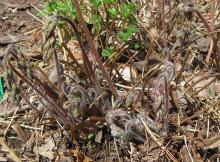
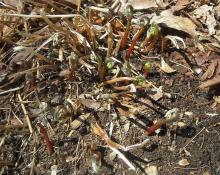

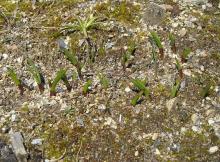

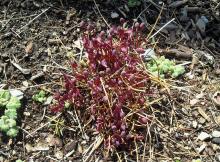

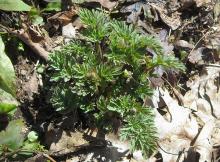
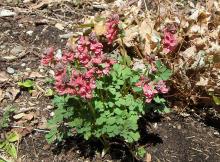













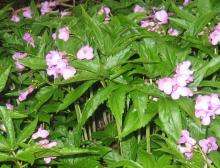



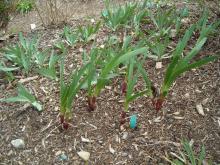





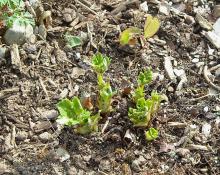















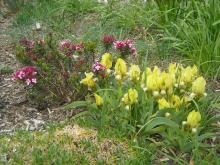



Lori, where I am heading now the Pulsatilla vernalis is still covered by feet of snow! It is a common plant some places in the interior of Norway. Hepatica nobilis is also common but along the coast. The latter is difficult to grow well in my garden, some beetles devour the leaves in summer . The leaves are however never damaged in winter.